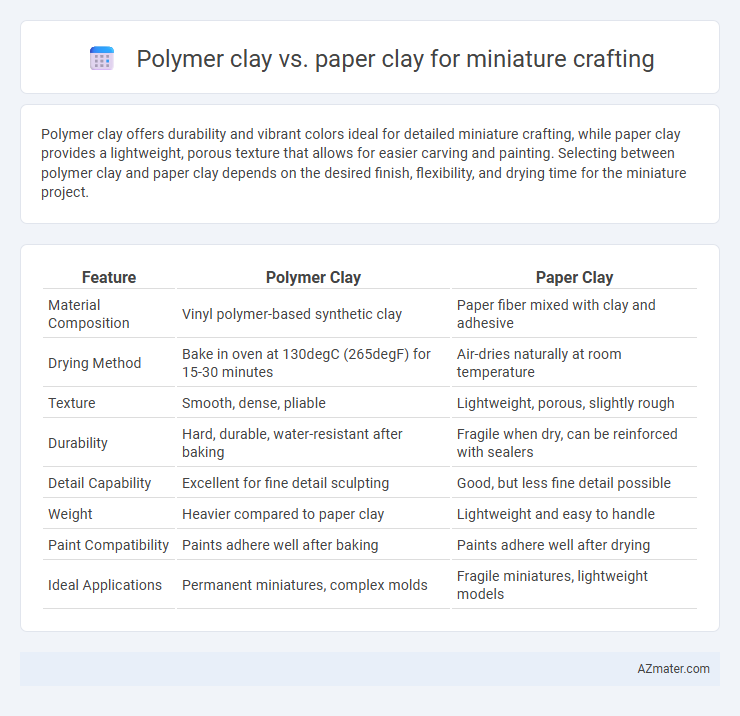Polymer clay offers durability and vibrant colors ideal for detailed miniature crafting, while paper clay provides a lightweight, porous texture that allows for easier carving and painting. Selecting between polymer clay and paper clay depends on the desired finish, flexibility, and drying time for the miniature project.
Table of Comparison
| Feature | Polymer Clay | Paper Clay |
|---|---|---|
| Material Composition | Vinyl polymer-based synthetic clay | Paper fiber mixed with clay and adhesive |
| Drying Method | Bake in oven at 130degC (265degF) for 15-30 minutes | Air-dries naturally at room temperature |
| Texture | Smooth, dense, pliable | Lightweight, porous, slightly rough |
| Durability | Hard, durable, water-resistant after baking | Fragile when dry, can be reinforced with sealers |
| Detail Capability | Excellent for fine detail sculpting | Good, but less fine detail possible |
| Weight | Heavier compared to paper clay | Lightweight and easy to handle |
| Paint Compatibility | Paints adhere well after baking | Paints adhere well after drying |
| Ideal Applications | Permanent miniatures, complex molds | Fragile miniatures, lightweight models |
Introduction to Miniature Crafting Clays
Polymer clay and paper clay are popular materials for miniature crafting due to their unique properties and ease of use. Polymer clay, made from a plastic-based compound, hardens when baked, allowing for detailed sculpting and durable finished pieces. Paper clay combines clay with cellulose fibers, offering a lightweight, air-dry option that is ideal for creating fine textures and intricate designs in miniatures.
What is Polymer Clay?
Polymer clay is a versatile modeling material composed of synthetic polymers, primarily polyvinyl chloride (PVC), combined with plasticizers to create a pliable, sculptable medium that hardens when baked at low temperatures around 265degF to 275degF (129degC to 135degC). This clay is favored in miniature crafting for its smooth texture, vibrant color options, and durable finish that resists cracking and moisture after curing. Unlike paper clay, polymer clay requires heat curing rather than air drying, enabling artists to build detailed, long-lasting miniature figures and accessories with precision.
What is Paper Clay?
Paper clay consists of a mixture of clay and paper fibers, offering a lightweight and flexible medium ideal for miniature crafting. Compared to polymer clay, paper clay dries air-based rather than requiring baking, allowing for easier manipulation and sanding after drying. This material excels in creating delicate details and textures while being more forgiving during sculpting due to its malleable consistency and reduced cracking.
Comparing Texture and Workability
Polymer clay offers a smooth, pliable texture that remains flexible until baked, allowing for precise detailing and durability in miniature crafting. Paper clay features a lighter, more porous texture that dries air-hard, making it easier to carve or sand but less flexible during the sculpting process. Workability differs as polymer clay requires baking to harden, ideal for intricate designs, while paper clay allows for longer working times and seamless blending before drying.
Curing and Drying Processes
Polymer clay cures through baking at temperatures between 265degF and 275degF (130degC to 135degC) for 15 to 30 minutes per quarter inch thickness, creating a durable, waterproof finish ideal for detailed miniature crafting. Paper clay dries naturally at room temperature, requiring several hours to days depending on thickness, and remains lightweight with a porous texture that can be sanded but is less water-resistant. Understanding these distinct curing and drying processes is essential for selecting the right clay based on project requirements and desired final durability.
Durability and Strength Differences
Polymer clay offers high durability and strength due to its dense, flexible composition that cures into a solid, water-resistant form, making it ideal for detailed miniature crafting that requires longevity. Paper clay, infused with fibers, is lighter and more porous, providing a delicate texture but less structural strength and higher brittleness compared to polymer clay. Consequently, polymer clay withstands handling and environmental stress better, while paper clay suits lightweight, decorative miniatures with less physical interaction.
Painting and Finishing Options
Polymer clay offers a smooth, non-porous surface ideal for acrylic paints, allowing for rich color layers and easy blending, while paper clay features a porous texture that absorbs paint, resulting in a matte finish and a more textured appearance. Polymer clay can be sealed with gloss or matte varnishes to enhance durability and shine, whereas paper clay benefits from lightweight sealers to prevent cracking while maintaining its delicate surface. Both materials support detailed finishing techniques, but polymer clay's flexibility offers more vibrant paint retention and versatile topcoat options for miniature crafting.
Safety and Handling Considerations
Polymer clay contains synthetic polymers that release fumes if overheated, requiring ventilation during baking, while paper clay is air-dry, non-toxic, and safer for use in enclosed spaces. Handling polymer clay demands caution to avoid ingestion or prolonged skin contact due to possible chemical exposure, whereas paper clay is generally hypoallergenic and easier to clean. Both materials benefit from thorough handwashing post-use, but paper clay offers a safer environment for children and hobbyists sensitive to chemical fumes.
Cost and Accessibility
Polymer clay offers a cost-effective solution for miniature crafting with widespread availability in art supply stores and online retailers, often priced between $5 to $15 per 2-ounce block. Paper clay, although slightly more expensive at around $8 to $20 per pack, provides unique lightweight properties but can be less accessible due to limited retail presence. Both materials cater to different crafting needs, making polymer clay preferable for budget-conscious creators seeking easy procurement.
Which Clay is Best for Your Miniature Project?
Polymer clay offers durability, vibrant colors, and fine detail retention, making it ideal for miniature projects requiring a sturdy, long-lasting finish. Paper clay, composed of clay mixed with cellulose fibers, provides a lightweight, air-dry option that is easier to sculpt and sand but less durable than polymer clay. Choosing the best clay depends on whether your miniature project prioritizes strength and color vibrancy (polymer clay) or lightness and ease of shaping (paper clay).

Infographic: Polymer clay vs Paper clay for Miniature crafting
 azmater.com
azmater.com